CPR, or cardiopulmonary resuscitation, is a lifesaving technique. It used to revive individuals who are experiencing cardiac arrest, a condition where the heart stops beating. CPR involves chest compressions and rescue breaths to help circulate blood and oxygen to vital organs until advanced medical care can be provided. However, there are certain situations where CPR may be stopped based on specific criteria. Here are five times when CPR may be discontinued:

- When a qualified medical professional arrives: If a qualified medical professional, such as a doctor or paramedic. It arrives at the scene and takes over CPR, it may be appropriate to stop CPR. Medical professionals are trained to assess the situation, determine the patient’s condition, and provide appropriate medical care. If they determine that further attempts at resuscitation are unlikely to be successful, they may decide to discontinue CPR.
- When the patient shows signs of life: If the patient shows signs of life, such as breathing spontaneously, coughing, moving, or showing a pulse, CPR may be stopped. CPR is intended to restore circulation and oxygenation to vital organs. If these signs of life return, it may indicate that the patient’s condition has improved. That further CPR may not be necessary.
- CPR is a physically demanding procedure, and fatigue can set in after an extended period of time. If CPR has been performed continuously for an extended period of time without any signs of life returning, it may be appropriate to stop CPR. The duration of CPR can vary depending on the situation, and medical guidelines. CPR should be continued until qualified medical help arrives or until the rescuer is too exhausted to continue effectively.
- When the situation is unsafe: CPR may need to be stopped if the environment is unsafe for the rescuer or the patient. For example, if there is a risk of a building collapsing, a fire, or an explosion, it may not be safe to continue CPR. Rescuers should always prioritize their own safety. Take appropriate measures to ensure that the environment is safe before continuing CPR.
- When the patient has a valid “Do Not Resuscitate” (DNR) order: A DNR order is a legal document that indicates a person’s preference not to receive CPR. Other life-sustaining treatments in the event of cardiac arrest or other medical emergencies. If a patient has a valid DNR order, CPR should not be initiated or should be discontinued if it has already been started. It is important to respect the patient’s wishes as expressed in the DNR order and follow applicable laws and regulations.
It is crucial to note that the decision to stop CPR should always be made by qualified medical professionals. It based on a thorough assessment of the patient’s condition and the specific circumstances of the situation. CPR should be continued as long as it is deemed medically appropriate and feasible. The decision to stop CPR should not be taken lightly. In some cases, CPR may be continued for an extended period of time in an effort to save a person’s life, while in other situations. It may be appropriate to discontinue CPR based on the factors mentioned above.
In conclusion, CPR is a critical lifesaving technique used to revive individuals in cardiac arrest. However, there are certain situations where CPR may be stopped. Including when a qualified medical professional arrives, when the patient shows signs of life. When CPR has been performed for an extended period of time, when the situation is unsafe, or when the patient has a valid DNR order. It is essential to follow established medical guidelines, laws, and regulations. To consult with qualified medical professionals in making decisions about when to stop CPR.
